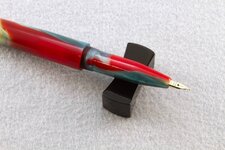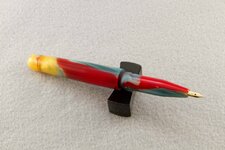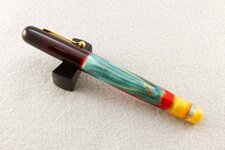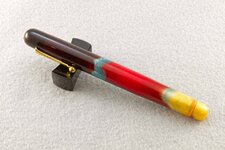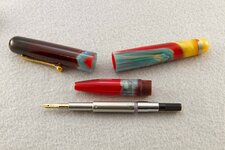Beautiful work !! ... Couple of questions ...
How did you make the notch that mates with the key ?
It looks like your barrel has a removable end which, I assume, is for removing/replacing the unit.
The nib section unscrews ... would the problem you noted disappear if you removed/replaced the unit by unscrewing the nib section ?
On the original VP pen a notch is cut in the threads of the body section to guide the "key" in the alignment of the nib/cartridge converter unit. (Remember it is a pen with a traditional "click" pen configuration, i.e., no cap) Rather than do that myslf, I selected a section tenon thread size that gave me enough "meat" to take a small circular rasp bit to cut a small notch large enough to receive the key, but not so large there is play in the fit. This key fit then keeps the nib from rotating. Below is a discussion about why the section is performing several of the roles associated with the traditional body of the pen.
The removable section end serves multiple purposes. As you noted, it is the means to remove and service the cartridge converter; it also serves to keep the pen to a manageable length because a significant part of the nib/cartridge converter unit is in the section and not completely in the pen body; and by placing the cap threads on the section itself in front of the section tenon threads I avoid the traditional arrangement of the pen body tenon being threaded for the cap threads on the top and internal threads to receive the section. On small pens this thread "stacking" runs the risk of creating a thin tenon wall. On the other hand, with pairs of adjacent threads as on my section, you need a long reach to use a die to create the cap thread or you have to turn them on your lathe. The section unit also has to be small enough the cap can cover it, because the cap is serving the function of the trap door closure of the original VP pen. The section can't be so big that removal of material from inside the cap materially weakens it or makes it transparent.
You could creat a removeable nose cone section to reduce the possibility of wicking. Before I add that layer of complexity I'll use an appropriately sized drill bit for "just the right amount of clearance." That also means fewer pieces. The long section length on my pen also enables your fingers to grip the section well past any threads for the cap, more comfortable.
All these are great questions and serve to illustrate all the trade offs we make when we are designing our own pens. I heartily encourage people to try things differently. Sometimes the only way I find a better solution is to do something the wrong way the first time, because that may be the only way you discover it is the wrong way, LOL.
I hope I answered your questions. The opinions are my own, but the mispellings are the iPad's fault, chuckle.

